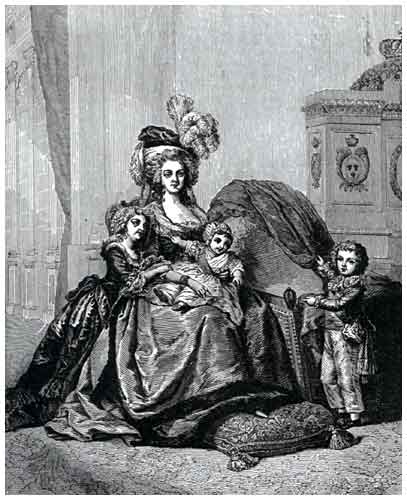 |
 |
 |
|
|
Marie Antoinette and Her Children
From the painting by Louise-Elizabeth Vigee Lebrun
|
...introduction continued; LOUISE-ELIZABETH VIGEE LEBRUN is one of the very few women who have not only achieved a reputation for excellence in art in their own time, but who have been accepted by the generation that has succeeded them, if not at the precise valuation of their contemporaries, at least with but a small deduction from it. She was born in Paris, in 1755, and died there in 1842. Her distinction was gained by her portraits, and she has left behind her a gallery of nearly all the men and women of her time who played important parts in their several worlds of politics, literature, art, or fashion. Her maiden name was Vigee; she married, when quite young, a Monsieur Lebrun; it was a marriage of convenience arranged by her mother, and proved most disastrous to her happiness. The sole consolations she found for the miseries entailed by an unsuitable union were in her art, and in the education of her only daughter. She was introduced at the Court of Louis XVI. And Marie Antoinette, and she was so much esteemed, and her art so much admired by their majesties, that she soon found herself engrossed with work, and in the intervals of her professional labor obliged to respond to the demands made upon her time by the highest society of her day. This prosperity did not, however, last long: the Revolution broke out, and Madame Lebrun was obliged to flee from Paris. She sought refuge in Italy, and spent some time in Berlin and St. Petersburg, and when she returned she found a new world rising on the ruins of the old; her royal friends dead, and the members of the society in which she had lived, either passed away or hopelessly scattered. Yet she took her place bravely in the ranks, resumed her work, and found a sympathetic public for which she long continued to paint. She has left behind her, beside her many pictures, a Memoir which contains much that is interesting relating to herself and her times. The picture we engrave is one of the most important of her portraits of the Queen. It represents Marie Antoinette with her three children: Maria Theresa, afterward the Duchesse d'Angouleme, the first Dauphin, who died soon after this picture was painted, and the baby Duc de Normandie, who became the Dauphin on the death of his brother and whose wretched fate has moved the sympathies of the world. The young princess clings caressingly to her mother's side and looks up lovingly into her face; the Queen holds the baby prince upon her lap while the Dauphin lifts the curtain of the cradle with one hand and points to his baby brother with the other. This picture, when completed, was hung in the gallery of the palace along which the Queen passed daily to and from her apartment in going to mass, but after the death of her eldest son she was too much affected by her grief to endure the daily sight of his portrait, and caused it to be removed. Among the many traits of the Queen's amiability and consideration for the feelings of others, recorded by Madame Lebrun, it may be mentioned that when she had ordered the picture to be removed she took care to have the reason for her action explained to the artist, lest her susceptibilities should be wounded. Madame Lebrun speaks as kindly of the King as of the Queen, and tells the anecdote that when he came to look at this picture, he regarded it for some time, and then turning to her, said; "Madame Lebrun, I do not know much about painting, but you make me love it." Madame Lebrun had a genuine affection for the Queen, and in her memoirs she always speaks of her with strong feeling, while all that she has to tell of her intercourse with her reflects a most pleasing light upon the characters of both the artist and the sovereign. Madame Lebrun has left several portraits of herself which have been engraved, and which still enjoy great popularity. While in Russia she was well received by the Czarina Catharine II., whose portrait she painted; and in Berlin, Queen Louisa sat for her, and the picture is one of the best that remains to us of that noble, beautiful, and unfortunate lady. continued... |
